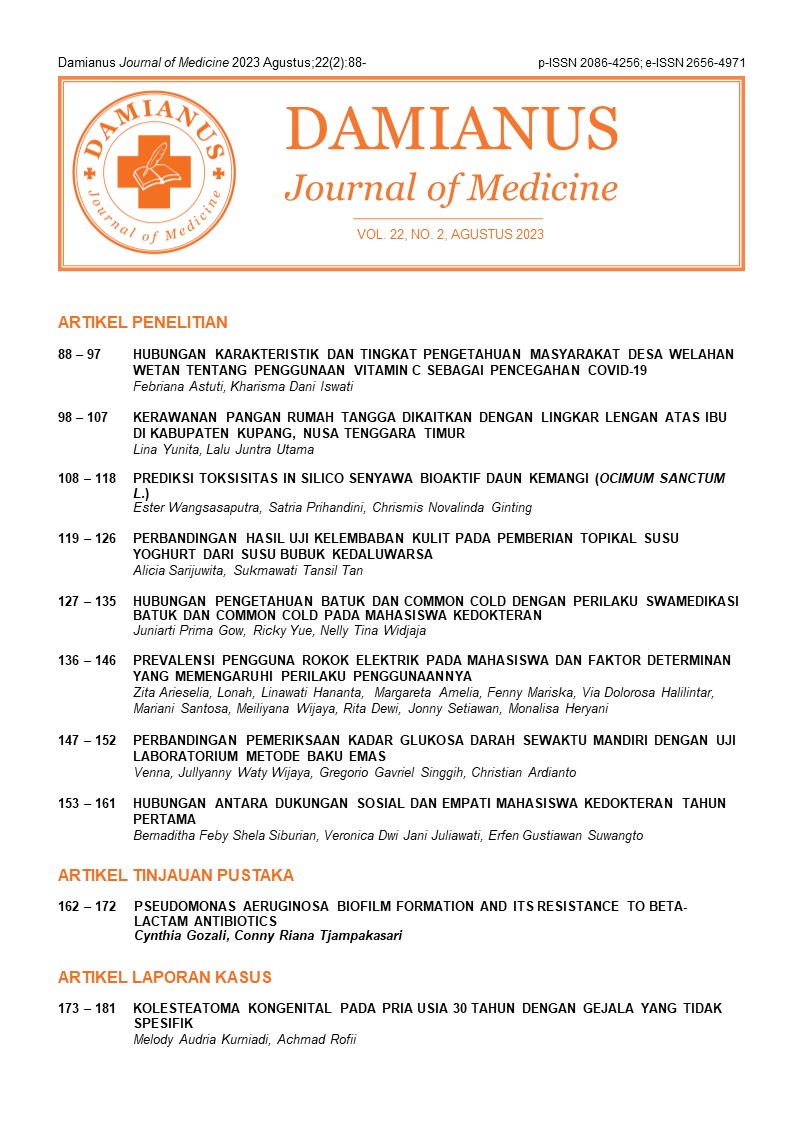Prevalensi pengguna rokok elektrik pada mahasiswa dan faktor determinan yang memengaruhi perilaku penggunaannya
DOI:
https://doi.org/10.25170/djm.v22i2.3820Keywords:
faktor determinan, mahasiswa, perilaku, prevalensi, rokok elektrikAbstract
Pendahuluan: Prevalensi pengguna rokok tembakau pada remaja di Indonesia terus meningkat dari 7,2% pada tahun 2013 menjadi 9,1% pada tahun 2018, tingkat penggunaannya dianggap dapat dikurangi dengan menggunakan rokok elektrik. Namun sebenarnya rokok elektrik belum dapat disebut sebagai terapi berhenti merokok konvensional karena belum terdapat bukti yang cukup kuat dan dampak penggunaannya pada kesehatan yang tidak dapat dikesampingkan. Sementara itu, beberapa studi menunjukkan bahwa penggunaan rokok elektrik juga berdampak buruk bagi kesehatan. Tujuan penelitian ini adalah untuk mengetahui prevalensi pengguna dan faktor determinan yang memengaruhi perilaku penggunaan rokok elektrik pada mahasiswa.
Metode: Studi ini merupakan penelitian kuantitatif dengan desain studi potong lintang atau cross sectional. Sampel yang digunakan sebanyak 410 orang dengan kriteria inklusi berupa mahasiswa aktif Unika Atma Jaya serta orang yang telah setuju untuk menjadi responden penelitian setelah membaca informed consent, dan kriteria eksklusi yaitu responden yang mengisi kuesioner dengan tidak lengkap. Perhitungan sampel dilakukan dengan metode proportional stratified random sampling. Pengambilan data responden menggunakan kuesioner secara daring melalui Google Forms. Analisis data menggunakan uji Chi Square dan Mann-Whitney.
Hasil: Prevalensi pengguna rokok elektrik pada mahasiswa sebesar 21,7%. Pada penelitian ini faktor yang berpengaruh pada keputusan penggunaan rokok elektrik adalah jenis kelamin (p<0,001), persepsi (p<0,001), tersedianya suplai (p<0,001), dukungan keluarga (p=0,002), dan dukungan teman (p<0,001).
Simpulan: Tingginya tingkat penggunaan rokok elektrik pada mahasiswa menunjukkan perlunya informasi dan edukasi serta promosi kesehatan mengenai dampak merugikan dari penggunaan rokok elektrik.
Downloads
References
WHO. Electronic nicotine delivery systems and electronic non-nicotine delivery systems (ENDS/ENNDS). World Health Organization; 2016; [cited 2020 Apr 29]. Available from: https://www.who.int/fctc/cop/cop7/FCTC_COP_7_11_EN.pdf
Jankowski M, Brożek G, Lawson J, Skoczyński S, Zejda JE. E-smoking: Emerging public health problem?. Int J Occup Environ Health. 2017;30:329-44.
Kementerian Kesehatan RI. Hasil Utama Riskesdas 2018. Badan Penelitian dan Pengembangan Kesehatan Kementerian RI; 2018 [cited 2020 May 1]. Available from https://www.litbang.kemkes.go.id/hasil-utama-riskesdas2018/
WHO. GHO world health statistics data visualizations dashboard tobacco smoking. World Health Organisation; 2018 [cited 2020 Apr 30]. Available from: https://apps.who.int/gho/data/node. sdg.3-a-viz?lang=en
Onor I, Stirling D, Williams S, Bediako D, Borghol A, Harris M, et al. Clinical effects of cigarette smoking: epidemiologic impact and review of phar-macotherapy options. Int J Environ Res Public Health. 2017;14:1147.
Annechino R, Antin T. Taking sides in e-cigarette research. Proceeding of the Ethnographic Praxis in Industry Conference, 2016 September 7-10. p.105-19.
WHO. WHO report on the global tobacco epidemic, 2019: offer help to quit tobacco use. World Health Organization; 2020.
Bals R, Boyd J, Esposito S, Foronjy R, Hiemstra PS, Carlos A, et al. Electronic cigarettes: a task force report from the European Respiratory Society. Eur Respir J. 2019;53:180115.
Elsa MS, Nadjib M. Determinan rokok elektrik di Indonesia: data SUSENAS (Survei Sosial Ekonomi Nasional) tahun 2017. Berita Kedokteran Masyarakat. 2019;35(2):41-8.
Kementrian Kesehatan RI. Laporan Riskesdas 2018 Nasional. Kementrian Kesehatan RI; 2018
Rohmani A, Yazid N, Rahmawati AA. Rokok elektrik dan rokok konvensional merusak alveolus paru. Proceeding of the Seminar Nasional UNIMUS, 2018 October 27. Semarang: Lembaca Penelitian dan Pengabdian Masyarakat Universitas Muhammadyah Semarang; 2018. p.27-32.
Allen JG, Flanigan SS, LeBlanc M, Vallarino J, MacNaughton P, Stewart JH, et al. Flavoring chemicals in e-cigarettes: Diacetyl, 2,3-pentanedione, and acetoin in a sample of 51 products, including fruit-, candy-, and cocktail-flavored e-cigarettes. Environ Health Perspect. 2016;124:733–9.
Putra IGNE, Putra IMR, Prayoga DGAR, Astuti PAS. Gambaran pemahaman, persepsi, dan penggunaan rokok elektrik pada siswa sekolah menengah atas di kota Denpasar. Proceeding of the 4thIndonesian Conference on Tobacco or Health, 2017 May 14-16. Jakarta: Ikatan Ahli Kesehatan Masyarakat Indonesia; 2017. p.2-12.
Devhy NLP, Yundari AIDH. Faktor yang berpe-ngaruh terhadap perilaku merokok konvensional dan elektrik pada remaja di kota Denpasar. Bali Medika Jurnal. 2017;4:63–72.
Istiqomah DR, Cahyo K, Indraswari R. Gaya hidup komunitas rokok elektrik Semarang vaper corner. Jurnal Kesehatan Masyarakat. 2016;4:203-12.
Karuniawati A. Faktor-faktor yang mempengaruhi penggunaan rokok elektrik (vape) pada siswa SMP Negeri se-Kecamatan Rembang Kabupaten Purbalingga [skripsi]. Semarang: Program Pascasarjana, Universitas Negeri Semarang; 2019 [cited 2021 June 20]. Available from: http://lib.unnes.ac.id/32750/1/1301414122.pdf
Zarobkiewicz MK, Wawryk-Gawda E, Woźniakowski MM, Sławiński MA, Jodłowska-Jędrych, B. Tobacco smokers and electronic cigarettes users among Polish universities students. Rocz Panstw Zakl Hig. 2016;67:75–80.
Pitriyanti L, Wirawan D, Sari K, Kurniati D, Duana I, Wirawan I. Factors affecting the use of electronic cigarettes in Udayana University students. PHPMA. 2018;6:88-92.
Cleopatra A, Fitriangga A, Fahdi F. Faktor-faktor yang berhubungan dengan penggunaan rokok elektrik di wilayah Kecamatan Pontianak Barat. ProNers. 2019;4(1).
Bigwanto MB, Nurmansyah MI. Keterjangkauan dan ketersediaan rokok elektronik dan hubungan-nya dengan perilaku vaping pada remaja di Jakarta [laporan]. Jakarta: Program Studi Kesehatan Ma-syarakat Fakultas Ilmu-Ilmu Kesehatan Universitas Muhammadiyah Prof. Dr. Hamka; 2018. [cited 2021 June 20]. Available from: http://simakip.uhamka. ac.id/download?type=penelitianlaporan&id=317&n omor=1
Piñeiro B, Correa JB, Simmons V N, Harrell PT, Menzie NS, Unrod M, et.al. Gender differences in use and expectancies of ecigarettes: Online survey
results. Addict Behav. 2016;52:91–97.
Agina T, Pertiwi F, Avianty I. Faktor-faktor yang berhubungan dengan perilaku penggunaan vapor di kalangan siswa sekolah menengah kejuruan Bina Sejahtera 2 kota Bogor. Promotor. 2019;2(2):
-11.
Hasna F, Cahyo K, Widagdo L. Faktor-faktor yang berhubungan dengan penggunaan rokok elektrik pada perokok pemuladi SMA kota Bekasi. Jurnal Kesehatan Masyarakat. 2017;5:548-57.
Yosua D. Persepsi generasi milenial tentang penggunaan rokok elektrik (vape) di Kecamatan Medan Selayang tahun 2018 [skripsi]. Medan: Fakultas Kesehatan Masyarakat, Universitas Sumatera Utara; 2018. Available from: http:// repositori.usu.ac.id/handle/123456789/13341
Alawiyah SS. Gambaran persepsi tentang rokok elektrik pada para pengguna rokok elektrik di komunitas vaporizer Kota Tangerang [tesis]. Jakarta: Fakultas Kedokteran dan Ilmu Kesehatan, UIN Syarif Hidayatullah Jakarta; 2017. Available from: http://repository.uinjkt.ac.id/dspace/handle/ 123456789/35973
Lorensia A, Yudiarso A, Herwansyah FR. Persepsi, efektifitas dan keamanan penggunaan rokok elektrik (e-cigarette) oleh perokok aktif sebagai terapi dalam smoking cessation: mixed methods dengan pendekatan studi kuantitatif dan kualitatif. J. Trop. Pharm. Chem. 2017;4:66-78.
Pandayu A, Murti B. Effect of personal factors, family support, pocket money, and peer group, on smoking behavior in adolescents in Surakarta, Central Java. JHBP. 2017;2:98-111.
Damayanti A. Penggunaan rokok elektronik di komunitas personal vaporizer Surabaya. Jurnal Berkala Epidemiologi. 2016;4(2):250-61.
Ladesvita F, Agustina E. Faktor-faktor yang mempengaruhi remaja mengkonsumsi rokok elektrik (vape) di wilayah Jakarta Utara. JAKHKJ. 2017;3(2):48-55.
Downloads
Published
Issue
Section
License
Copyright (c) 2023 Damianus Journal of Medicine

This work is licensed under a Creative Commons Attribution-ShareAlike 4.0 International License.














